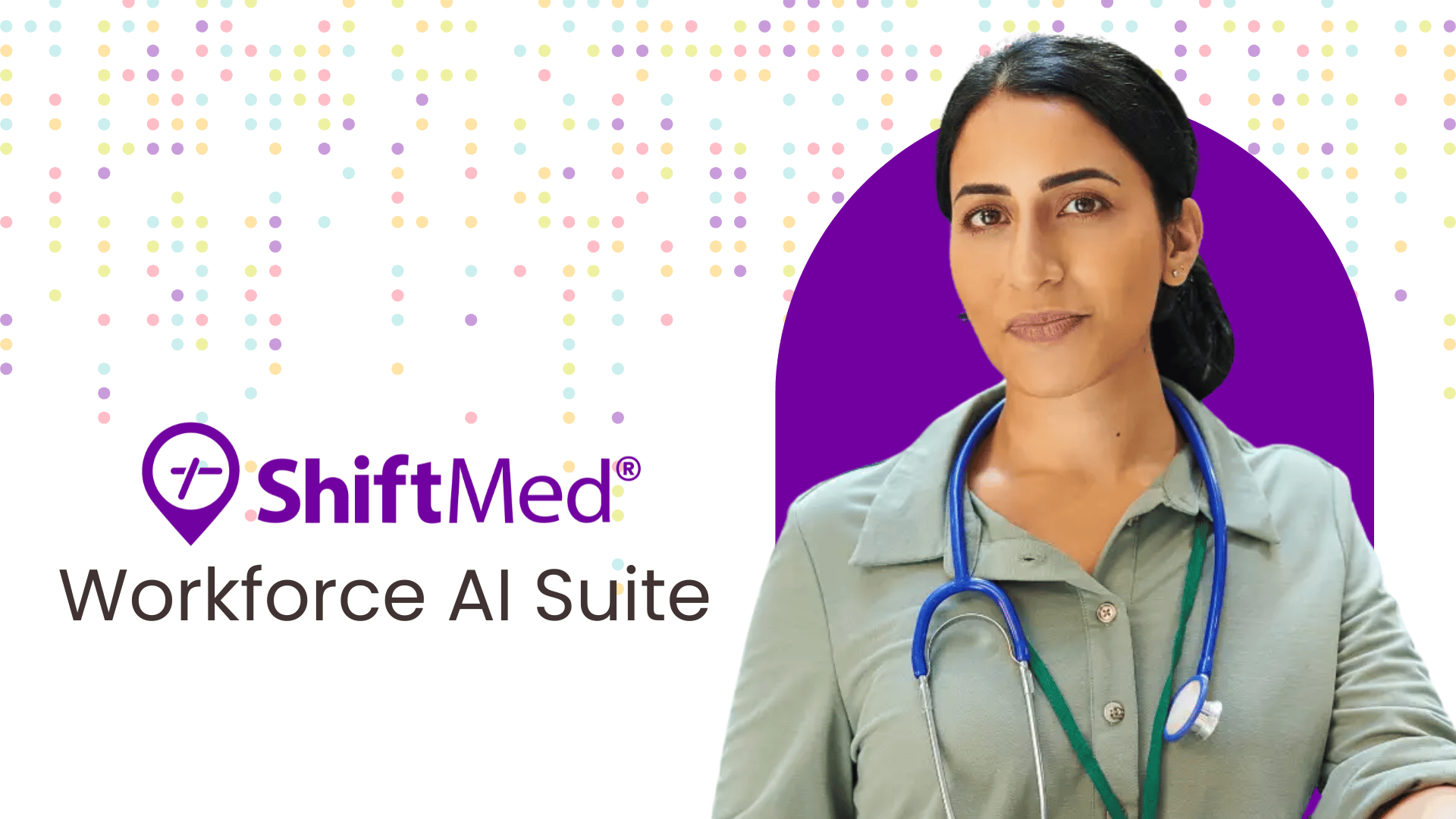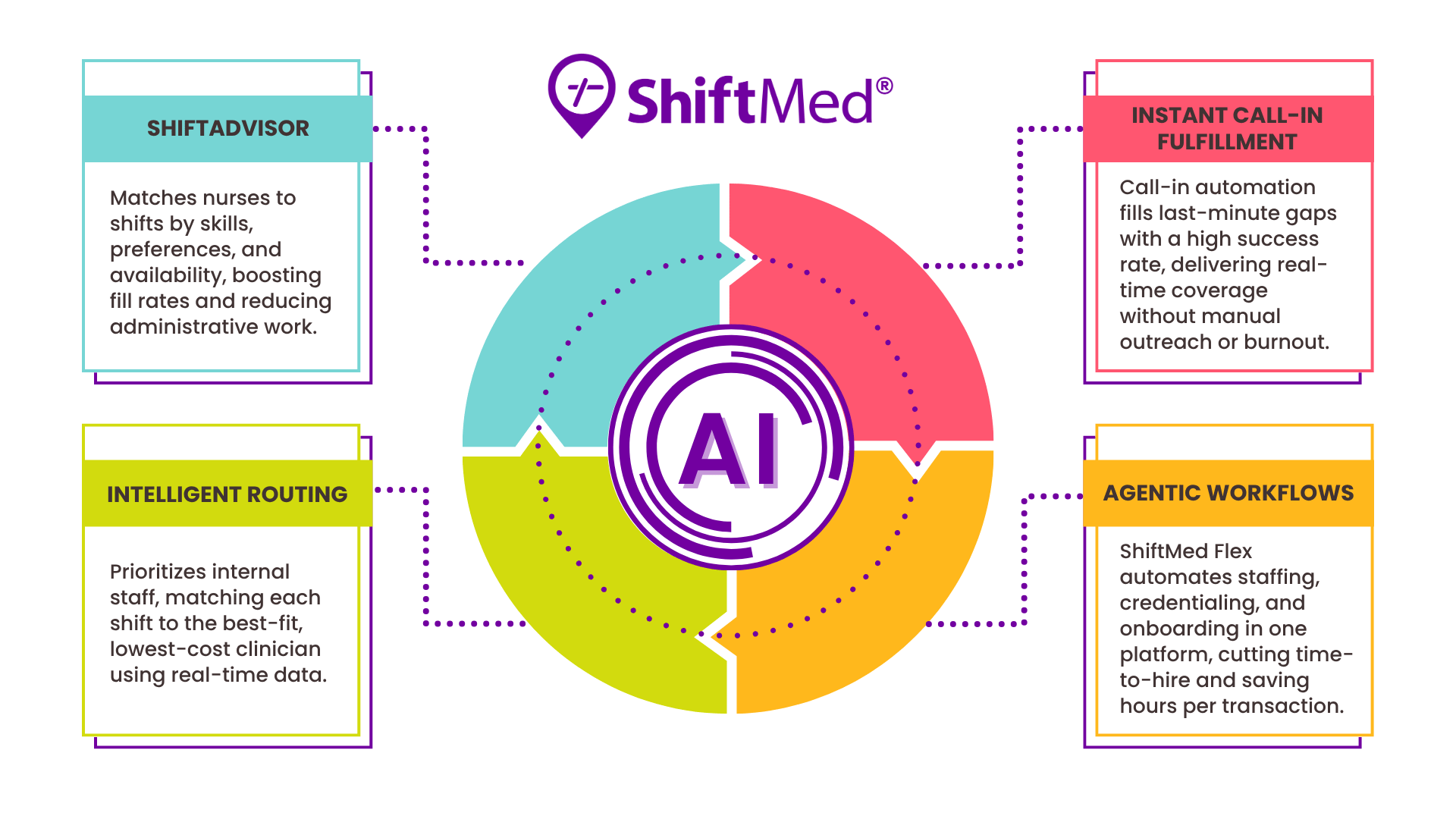AI in Healthcare Staffing: From Buzzword to Breakthrough

Artificial intelligence is no longer a futuristic concept—it's a real-time solution to some of healthcare’s biggest pain points. As hospitals and health systems face mounting pressure to do more with less, AI in healthcare staffing is emerging as a powerful tool to streamline operations, reduce administrative burden, and close critical gaps with precision.
Through innovative AI-powered workforce solutions, ShiftMed is setting new standards in healthcare workforce optimization, ensuring nursing teams and healthcare organizations can manage operations with the utmost ease. This article explores the multifaceted ways AI impacts healthcare staffing.
Persistent Healthcare Staffing Challenges
Behind every filled shift lies a web of complex challenges that healthcare facilities must navigate daily. From strict compliance requirements and unpredictable staffing demands to maintaining high standards of care and battling operational inefficiencies, staffing is far more than a logistical exercise—it’s a high-stakes balancing act.
As workforce pressures continue to mount, these pain points underscore the urgent need for smarter, more adaptive solutions. Here’s a look at what makes healthcare staffing so difficult and why innovation can’t wait.
Complex Compliance Requirements
Healthcare staffing isn't just about filling vacancies; it's about ensuring that every professional placed meets stringent compliance standards. From certifications to training, healthcare facilities must navigate a maze of regulations to ensure their staff is qualified and compliant with local, state, and federal guidelines. This makes it incredibly difficult to fill vacant spots and opens up healthcare facilities to immense legal and financial risks.
Demand & Supply Imbalances
One of the most pressing challenges is the fluctuating demand for healthcare staff. Seasonal illnesses, pandemics, or sudden patient influxes can strain resources. Conversely, overstaffing during quieter periods can lead to financial inefficiencies. When there’s a sudden surge in demand for staff, it’s hard for healthcare facilities to fill those spots at a moment’s notice. Balancing this demand with the available supply of nursing staff is a constant juggling act.
Ensuring Quality Control
Beyond just filling positions, healthcare facilities prioritize the quality of care. This means hiring qualified professionals and ensuring that they align with the facility's values, culture, and patient care standards. Achieving this level of quality control in staffing decisions is both crucial and challenging. However, maintaining such a high level of quality in nursing staff can further create bottlenecks in the hiring and staffing processes.
Operational Inefficiencies
Traditional staffing methods, reliant on manual processes, can be time-consuming and error-prone. From vetting applications to managing shift schedules, these operational inefficiencies can lead to gaps in patient care, staff burnout, and increased operational costs. In fact, healthcare facilities are currently contending with an incredibly high turnover rate amongst nursing staff due to the incredible administrative burden placed on nurses.
Why Efficient Healthcare Staffing Is Important
Healthcare staffing isn’t just a logistical challenge—it’s a strategic priority. From improving patient outcomes to controlling costs and supporting clinician well-being, the way an organization manages its workforce has a ripple effect across every aspect of care delivery. Here’s how an optimized workforce drives impact across the board:
Optimal Patient Care
Efficient and accurate staffing ensures that healthcare organizations have the right number of professionals with the necessary skills at all times. This directly impacts the quality of patient care, ensuring timely attention and reduced wait times.
Financial Implications
Overstaffing drains resources, while understaffing risks care quality—and both come at a high cost. Efficient staffing strikes the right balance, helping healthcare organizations optimize labor, reduce overhead, and operate more cost-effectively.
Nurse Satisfaction & Retention
A well-managed workforce prevents nurse overload, easing burnout and boosting job satisfaction. It’s also essential for retaining top talent, which is critical in addressing nursing shortages.
Operational Smoothness
Efficient staffing means smoother operations that result in fewer last-minute shift changes, consistent care, and enhanced resource allocation. This stability helps healthcare organizations attract and retain top nursing talent.
4 Benefits of AI in Healthcare Staffing
AI is transforming how healthcare organizations match, hire, and manage clinical talent, delivering faster, smarter, and more cost-effective results than ever before. Here’s how AI is changing the game:
1. Precision Matching
AI can match nurses with different facilities and units with unparalleled accuracy. By analyzing vast datasets, AI can consider qualifications, past performance, patient needs, and facility culture to make optimal matches. This ensures that organizations get professionals who meet the required standards and align with their specific needs and values.
2. Speed & Responsiveness
Traditional staffing methods can be time-consuming, often involving manual vetting and decision-making. AI in healthcare staffing can process information and make recommendations in real time. This rapid response is invaluable, especially when facilities face sudden workforce shortages or must address immediate patient care demands.
3. Cost-Efficiency
By streamlining the staffing process and reducing the time and resources spent on finding the right nurses, AI can lead to significant cost savings for healthcare organizations. Moreover, AI's precision ensures that facilities avoid the financial implications of misclassifying nurses, which can lead to legal and financial burdens.
4. Future-Ready Adaptability
AI technology continuously learns and adapts. As it processes more data, its recommendations become even more refined, ensuring that healthcare organizations remain equipped with the most advanced and effective workforce solutions.

ShiftMed Workforce AI Suite
ShiftMed is at the forefront of healthcare workforce innovation, offering a platform that seamlessly connects hospitals and health systems with a vast pool of qualified W-2 healthcare professionals. Our AI-powered technologies and algorithms help facilities fill shifts fast, streamline administrative tasks, and more.
ShiftAdvisor™: AI That Puts Clinicians in Control
This technology uses AI to match clinicians with open shifts based on their preferred days, times, pay, and locations. With a 94% opt-in rate for self-scheduling and over 3.3 million matches made, it eliminates scheduling friction and keeps clinicians happy, engaged, and in the driver’s seat.
Intelligent Routing™: Smarter Shifts, Lower Costs
This technology uses AI to direct over 6.4 million shifts to the most cost-effective labor source—cutting dependency on pricey external agencies. With a public API that integrates directly into hospital systems, early adopters are saving an average of $300 per shift.
Instant Call-In Fulfillment: Last-Minute Shifts, Handled
Our call-in automation fills last-minute shift gaps fast, achieving a 71% replacement rate without manual outreach. No more scrambling, no more burnout. Just seamless, real-time coverage when you need it most.
Agentic Workflows: Automate Everything, Hire Faster
ShiftMed Flex powers centralized, automated workflows for staffing, credentialing, and onboarding, giving health systems full control, from compliance to day-one readiness. With everything managed in one platform, organizations are cutting time-to-hire by 29 days and saving over two hours per scheduling and credentialing transaction.
Embracing AI for a Stronger Healthcare Workforce
The challenges facing healthcare staffing are complex and evolving, but so are the solutions. Artificial intelligence is no longer just an emerging technology; it is a proven game-changer that empowers health systems to optimize resources, enhance patient care, and support their clinical teams like never before.
By leveraging AI-driven tools like ShiftMed’s Workforce AI Suite, healthcare organizations can overcome compliance hurdles, balance staffing demands, and streamline operations with speed and precision. This not only reduces costs and administrative burdens but also improves nurse satisfaction and retention, which are key factors in sustaining a resilient and high-quality workforce.
Schedule a free workforce consultation to learn more.